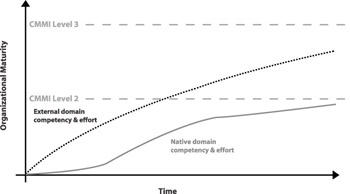THE MATURING CLIENT - CONSULTANT RELATIONSHIP
THE MATURING CLIENT ” CONSULTANT RELATIONSHIP
Presumably, your organization s goals for CMMI-based process improvement include increasing its process capability in software or systems engineering and increasing the overall organizational maturity. These are certainly the implied goals if the organization is striving to achieve a CMMI maturity level. Extrapolating these goals out into the future, they would also logically include the organization increasing its process capability and maturity in continuous process improvement.
Translation: Over time the organization s dependence on the expertise of outside process or CMMI consultants should decrease as the organization s base of expertise in this area increases . And this is exactly the point at which your organization s goals and the goals of the consultant or vendor may not only differ , they may conflict. It is in the long- term best interest of your organization to gradually transfer outside process expertise and knowledge into the organization so that it gradually depends less on the outsiders for its process improvement success. However, it is usually in the best interest of the consultant or vendor to maintain a high level of dependency because it maintains their revenue. The consultancy can accomplish its revenue goal by ensuring its expertise and knowledge does not get transferred into your organization. See the problem?
What Usually Happens
The client and the consultant start out with competencies in different areas. The client has competency in their organization and business and the consultant does not. The consultant has competency in organizational change, CMM and CMMI, and process improvement which the client does not possess. As the relationship moves through time, each party should naturally transfer their competencies to the other. Thus, the client becomes more competent and capable of process improvement and the consultant becomes more effective in providing organization-specific solutions because of the increased organizational knowledge. However, as illustrated in Figure 6.4, this is not what often happens.
As shown in Figure 6.4, what often happens is that the consultancy is maintaining a high level of domain competency (CMMI) and effort. The client organization initially climbs a steep CMMI and process improvement learning and effort curve, but then their energy tapers off as process improvement gets out-prioritized by other deliverables and efforts and as they continue to rely on the consultant to do the work. The results of the relationship path shown in Figure 6.4 are great for the consultant, but not so good for the client.

Figure 6.4: How the Client ” Consultant Relationship Usually Matures
What Should Happen
Figure 6.5 shows how the client ” consultant relationship should change over time to benefit the client.

Figure 6.5: How the Client ” Consultant Relationship Should Mature
In Figure 6.5, the consultant starts off with significantly greater domain knowledge (CMMI, process improvement) than the client organization which is, after all, presumably one of the reasons consultants are brought in to begin with. However, in order for the client organization to own the change and for continuous process improvements to become institutionalized, there needs to be gradual transfer of domain competency from the consultants to the client organization. As the client organization gains domain competency, the internal or native effort expended toward process improvement should also increase.
Of course, this presumes that there is a will and desire on the part of the consultant to transfer process improvement knowledge. It also assumes there is the will, ability, and availability of resources within the client organization to receive the transferring knowledge and skill.
The client ” consultant relationship paths shown in Figure 6.5 are good for the client because the process improvement gradually becomes a core competency in the organization, which makes their success in this area less dependent on outside expertise. What many consultants don t realize is that this is also good for them and the consulting industry. Their revenue from a single contract may diminish over time, but their reputation and marketability for new clients or follow-on work or expanded work in a different domain with existing clients increases.
EAN: 2147483647
Pages: 110